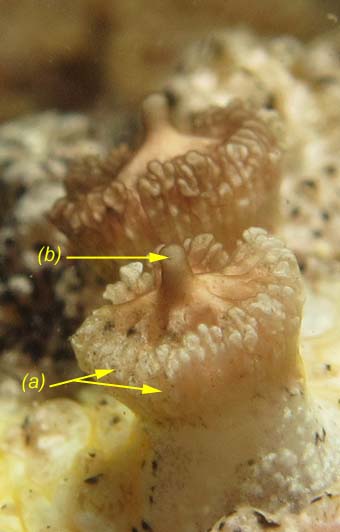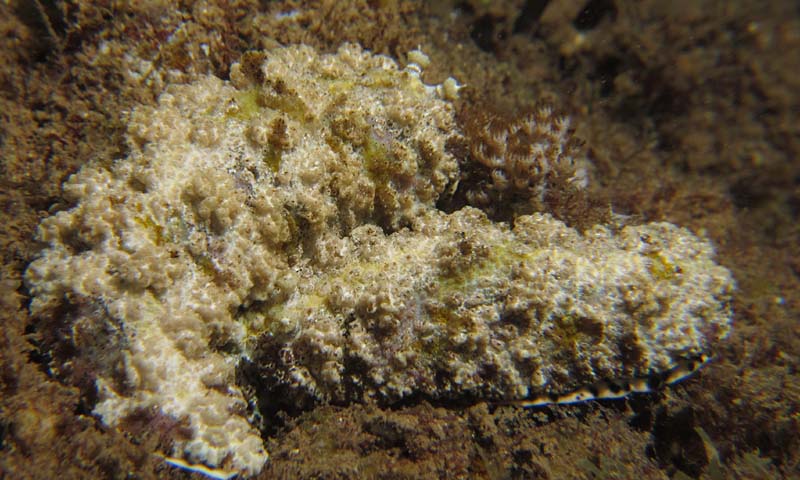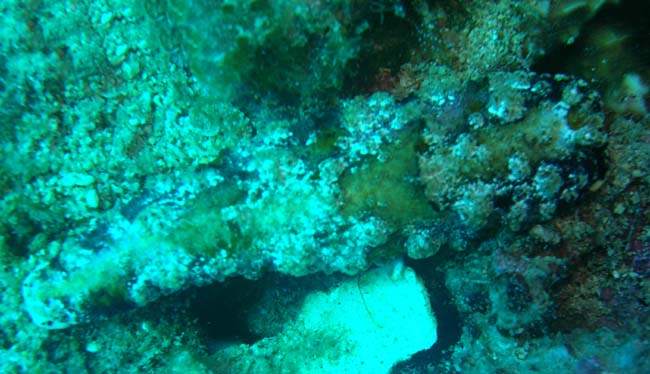This species has been observed on Mayotte and Madagascar Island
Recognized by the brownish mottle mantle with a serie of irregular pustules covering the notum The rhinophore stalk is white and the club is entirely tan. Dark speckling visible on the entire ventral surface.
|

|
|
| Showing species characteristics... | Photo Matthias Deuss |
|
Remarks :
Identification confirmed by Terry Gosliner and Nathalie Yonow
Synonymous : (according Worms)
- No other name
Bibliographic data :
In mature specimens the pustules are tipped with black spots
The ground colour of the dorsum and the foot is dominated by opaque white pigment, but there are areas of distinct pale blue or lavender, giving the overall appearance of marble.
- On the mantle, there are several distinct areas of mixed blue and tan pigment.
- There are two noticeable dark lines of pigment that divide the dorsum into approximate thirds.
- The dorsal ridges are mostly tan with some dark spots of colour randomly sprinkled.
- The depressions between the ridges are mixed white and pale blue.
The body shape of the living animal is elongate, but stocky, slightly flattened, and narrows at the posterior end.
The foot does not project beyond the distinct mantle margin.
The dorsum has very low, broken longitudinal ridges and tubercles that give a lumpy appearance to the notum.
The oral veil barely projects at the anterior end of the body. The oral veil is opaque white with dark spots along the margin.
The rhinophores are behind the oral veil. They have a series of longitudinal lamellae on the rounded club. The stalk does not narrow noticeably and the club has a small projecting tip. The rhinophore stalk is white with darker bands of tan and the club is entirely tan. The tip of the rhinophores is white with a dark band beneath the white.
The genital opening is situated in the anterior quarter of the body.
The anus is situated approximately half of the way to the posterior end of the body
Feeds on xeniid soft corals
References :
Nudipixel Dermatobranchus pustulosus
Publications :
Gosliner T.M. & Fahey S.J. (2011) Previously undocumented diversity and abundance of cryptic species: a phylogenetic analysis of Indo-Pacific Arminidae Rafinesque, 1814 (Mollusca: Nudibranchia) with descriptions of 20 new species of Dermatobranchus . Zoological Journal of the Linnean Society 161: 245–356.
Hasselt JC. 1824. Extrait d’une lettre du Dr J. C. van Hasselt au Prof. van Swinderen, sur mollusques de Java. Bulletin de Sciences Naturelles et de Geologie 2: 237– 245.
Other photos of Dermatobranchus pustulosus :
 |
Matthias Deuss
Mayotte, plage du Rocher, Petite Terre, less 1 m, 29 January 2012, size : 80 mm Dark speckling (a) visible on the entire ventral surface. In mature specimens the pustules are tipped with black spots (b) |
The rhinophores have a series of longitudinal lamellae (a) on the rounded club. The stalk does not narrow noticeably and the club has a small projecting tip (b). Its probable source of food...  |
 |
Matthias Deuss
Mayotte, plage du Rocher, Petite Terre, less 1 m, 29 January 2012, size : 80 mm A small population observed on this area during the day... |
 |
 |
Norbert Verneau Mayotte, Dzaoudzi, 3 m, 2 January 2011, size : 50 mm Always beside this soft coral... |
Alain Barrère Madagascar, Andavadoaka, 2005, size : 55 mm
|
 |
More photos from Indian Ocean
If you have taken a photo of this species in Reunion, Mauritius, Mayotteor Madagascar Islands, please Contact us...